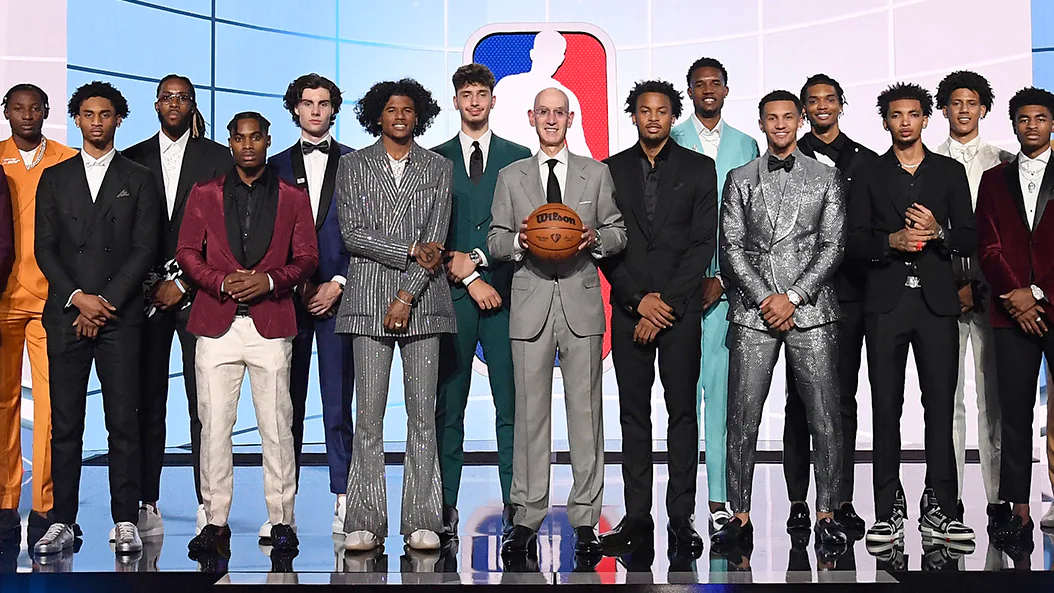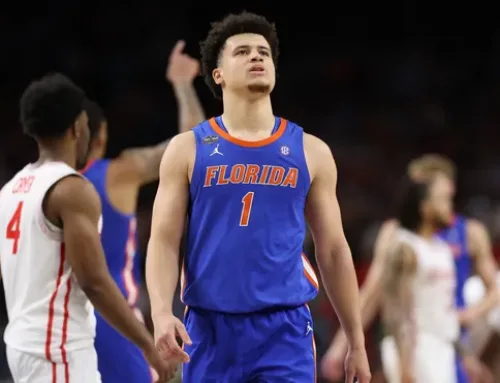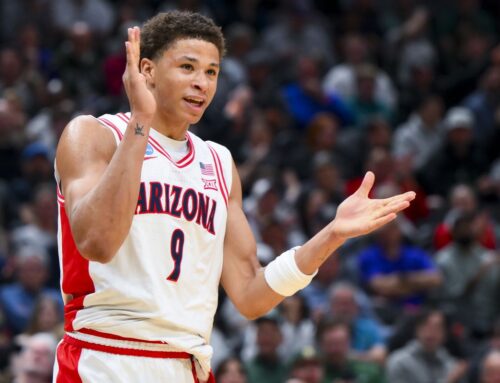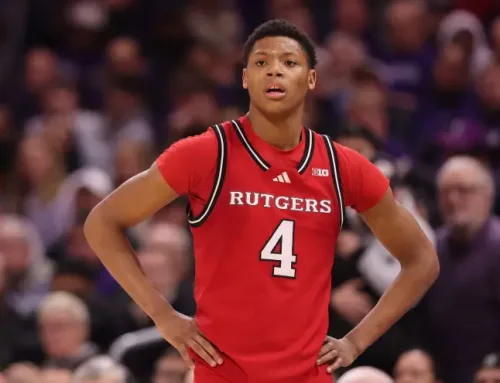By Avi Tyagi
The premise: Filling out a big board with the top 30 prospects from the 2021 Draft, roughly 2 seasons later. Much has changed, but on the whole, 19 of the original first rounders remain in this draft. While there were other candidates outside the top 30 selected here, the tier drop becomes sharper towards the tail end of the board and there happened to be a distinguishable difference between the last few in and the first few out. After last season’s extended rookie report coverage, it was only fitting that I double down during their sophomore seasons. Effective rookie contributors are often in short supply. With adjustments to the mental and physical rigors to the league, Year 2 often separates the wheat from the chaff. During their follow-up campaign, many future stars and high-level role players begin to carve out their place in rotations or to show flashes of excellence in the domain of their eventual superpower. A larger sample size to base career statistics off of makes distinguishing growth from general variance an easier task as well. I will write more about prospects who have taken larger leaps year over year, so a short paragraph does not signify that a sophomore has not improved. With that in mind, here are the first 6 tiers:
Tier 1: Sub-All-Star in Year 2
Evan Mobley
To become a focal point for success this early into a career can often portend a bright future. Young players, even in Year 2, are still maturing physically and mentally against opponents with more experience and in their primes. To be in the All-Star conversation with the deck stacked against you tends to presage multi-time All-Star potential as rapid improvements from the natural gains of maturity and experience enter the equation, before even factoring in the potential for skill development. There are 2 players who have separated themselves from the pack in this regard: Evan Mobley and Franz Wagner. Two of the spindliest prospects coming into the draft, each struggled with finishing near the rim and with at least one physical aspect of defensive play. Both have outgrown several of their concerns already within their sophomore season. Mobley, in particular, produced an impressive defensive debut that made it appear more likely than not that he could become a more effective post defender and physical rim protector as he adds to his frame. Giannis, AD, Capela, Bosh, teammate Jarrett Allen; there are an innumerable quantity of big men with a similar story. He has delivered on that promise thus far. Offensively, he’s built upon his big-to-big passing with Jarrett Allen and has improved tremendously as a finisher. The jumper is still a work in progress, but it’s nice to have him crushing dunks and making quick hooks around the paint in the meantime. In total, Mobley shows flashes of being a dominant threat in the paint offensively, while already being a DPOY candidate in his second season.
Tier 2: Consistent High-Level Offensive Play
Franz Wagner
Franz has benefitted from similar developments as Mobley, but with some unique and surprising additional elements. Between his freshman season at Michigan and now, he appears to have grown several inches and is now quicker north-south as a driver and more laterally mobile as a defender than he was even 12 months ago. It was not a development I had foreseen. A positionally solid defender beforehand, Franz is playing frenetically with an excellent cadre of perimeter defenders flanking him. Franz makes few rotational mistakes and is no longer an isolation mismatch target as he was at times last season. He’s become even more successful at beating stronger opponents off the dribble. His fluidity with his dribble and ability to make reads as a passer make him less like a big and more like a mega-wing. Marginal improvements across many facets of his game have built the foundations for a potential All-Star and a cornerstone of the up-and-coming Orlando Magic.
Tier 3: The Offensive Hubs
Cade Cunningham, Scottie Barnes, Josh Giddey, & Austin Reaves
Cade looked good in his 12-game sample this season. None of the concerns about his explosiveness or finishing ability were answered, but he looked even more in control than he always is and was a stabilizing on court presence for a youthful, inexperienced Pistons’ roster. Compellingly, his free throw rate improved with his added bulk and his added offensive load. I hope to see him make great strides over the next few seasons.
Scottie Barnes’ second season on the surface appeared to be more of the same. In reality, he has improved significantly as an on-ball shot creator for himself and for teammates. His defense was as solid as ever and he was effective in most defensive roles. His shooting stats finished only marginally worse and, in reality, Scottie only drops down to 4th here because of the leaps taken by his compatriots.
There was perhaps no better fit for an individual prospect than Oklahoma City has been for Josh Giddey. Josh has improved dramatically from last season, driven by his synergy with the OKC ethos. This team loves to crash the paint with drives from all angles and allows freedom to its young ball handlers to grow and develop together without becoming overly reliant on any one creator. Between Shai, the wonderful Jalen Williams, and Josh Giddey, this team has 3 quality offensive initiators. There is a through line between all 3: there were late bloomers in the draft cycle who have continued to improve dramatically as perimeter shot creators and rim finishers with OKC. Giddey is a relatively weak defender, but a perimeter shell built by Dort as the on-ball stopper with Jalen and Shai flanking him has allowed Giddey to be a tertiary component and to hide away on defense. His passing and ball movement are integral to keeping the offense flowing and generate high percentage shots in ball screens or on drives. He’s shooting 75% from the line with an improved shot form overall (perhaps driven by the addition of Chip Engelland). Most importantly, while his shot is a work in progress, he has now become sturdy enough to absorb contact and generate paint attacks on his own, on balance, without needing an exceptional advantage from picks. 68% of his shots this season come within 10 feet of the rim and a third of his shots are occurring right at the rim. Those are major improvements from last season and are coupled with a 5% improvement in finishing at the rim (from 58% to 63%). On the whole, he’s already a starter for a potential playoff team and that’s despite shooting 25% on above the break 3s. If the 3-point shooting improves and opponents have to decrease their cushion while defending him, he becomes an even more potent paint presence. On a macro-team scale, OKC’s rebuild is becoming something very special. This team is truly competing for the playoffs despite the lowest weighted average team age in the league and no true rim protector. With another year on their belt, more incoming draft picks, and the return of Chet, the path to becoming a perennial contender is truly within sight and Giddey is an essential integrant.
Austin Reaves, 3rd best player of a Western Conference Finalist. That is reality; what a world! Austin Reaves was tremendous post-trade deadline. His low-volume scoring in an on-ball or off-ball role was immensely valuable due to a 70% true shooting rate. The February trades restructured the team and created a ball handling void. Reaves stepped in. After the All-Star break, Reaves’s touches per game increased from 35.5 to 53.4 and he made good use of it. Gone was the meager 14% rate that categorized role-player-Reaves. In came secondary shot creator Austin Reaves. Reaves averaged 7.1 more points per game (from 10.5 to 17.6) and 3.3 more assists per game (from 2.2 to 5.5) after the break. His efficiency improved. With more spaced lineups surrounding him, Reaves was more effective at creating shots around the rim and finishing against fewer packed paints. He’s already extremely crafty, generating free throw attempts with ease (.541 free throw rate). He’s 85% from the line for his college and pro career, making every opportunity count and helping skyrocket his efficiency during stretches of hot 3-point shooting. In 23 regular season games after the break, Reaves finished with a monstrous 73.4% true shooting percentage. Here is the list of players post-All-Star to average more than 18 minutes per game with a usage rate above 16%, an assist percentage above 15%, and a True Shooting percentage above 66% (listed in order [from lower to higher] by TS%):
Kawhi Leonard
Domantas Sabonis
Tyrese Maxey
Joel Embiid
Kevin Durant
Nikola Jokic
Tyrese Haliburton
Jimmy Butler
Austin Reaves
Enough said. Well done! I’ve tentatively placed him at 6 only because we have yet to determine how far he can continue to scale up his offense. While his defense is acceptable, it’s not the driver of the appeal. If Austin Reaves can scale up this sort of production to higher usage through the use of more guile as a dribbler in isolation and improved burst to self-generate shots, his surge up the list will not stop here.
Tier 4: Tertiary Shot Creating Starter
Quentin Grimes
Quentin Grimes is role player perfection. Great defender on-and-off-ball, excellent ball-mover, decisive and capable 3-point shooter, he takes little off the table within his role. I’m not sure he can scale up to being more, due to a lack of craft as a self-creating driver and a solid if unspectacular first step, but I would not rule it out. I enjoy watching him play and appreciate the role he’s crafted for himself as a starter on the Knicks.
Tier 5: Polished Defensive Starter with Future DPOY Potential
Herb Jones
What a fantastic defender. Herb is and will continue to be one of the most superb defenders in all of basketball. Offensively, if he’s not a true starter yet, it’s not for a lack of trying. His stampedes to the hoop do improve the efficacy of placing him out at the perimeter, but he’s not yet a confident shooter. While I do expect him to improve to league average at some point, he’s below Grimes because of Grimes’ potential for shot-creating upside. Herb is one of the few sophomores who’s been a true plus player for his team within 2 seasons and “Not on Herb” is so formidable, the phrase even applies at times to opponents he’s not directly guarding. Few players are as dangerous hanging around at the nail and stunting at drives as Herb Jones. Few players can help cover for a team’s defensive weaknesses like Herb can and it’s why I love his game and have him at 8.
Tier 6: The Fun Playmaking Big
Alperen Şengün
This is where we enter the wild, wild west. From this point forward, sure starters are hard to come by and conjecture reigns supreme. In this new realm, a land with unorthodox hook shots and unexpected passing angles, Alpy is at home. Watching Alperun Sengun feels like watching a Sabonis sequel in almost every way. He’s more polished and a better rim protector than Sabonis, albeit with more defensive questions when in space, but the premise feels similar. He’s already on the small shortlist of centers able to create quickly and effectively in a spaced-out NBA with the vision to run handoffs and find cutters under the hoop. The list of centers to average over 12 minutes a game with a usage rate over 20% and assist percentage over 15% is 7 names long: Jokic, Embiid, Bam, Sabonis, Nurkic, Şengün, and Zach Collins. The first 3 names on that list have superpowers that he does not, but where on the spectrum might Alpy end up with the right development path? His defense was woeful, particularly in ball screens, but the Rockets as a whole were miserable and unwatchable on that front. He’s somehow still only 20 and perhaps all he needs is time to add strength, to become quicker with an added emphasis on lateral movement, and to simply improve his fundamentals and recognition of actions with experience and learning. I hope to see what he does with a new staff that will hopefully be more successful at enforcing solid defensive principles. The outcomes for Alpy could range from anywhere between defensive sieve who loses most of his effectiveness in a playoff setting to excellent center with an extended borderline All-Star peak. Regardless, I consider it more likely than not that Alperun Sengun ends up being a very productive regular season player within a few seasons and thus have him at 9th on this board.
